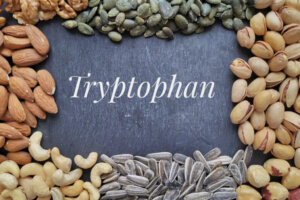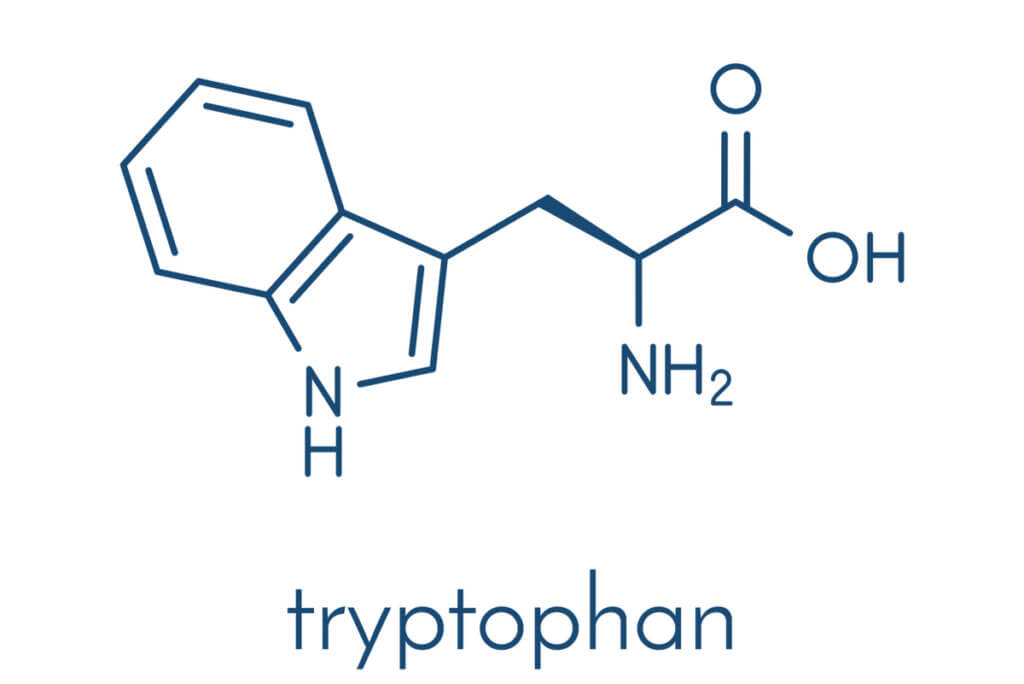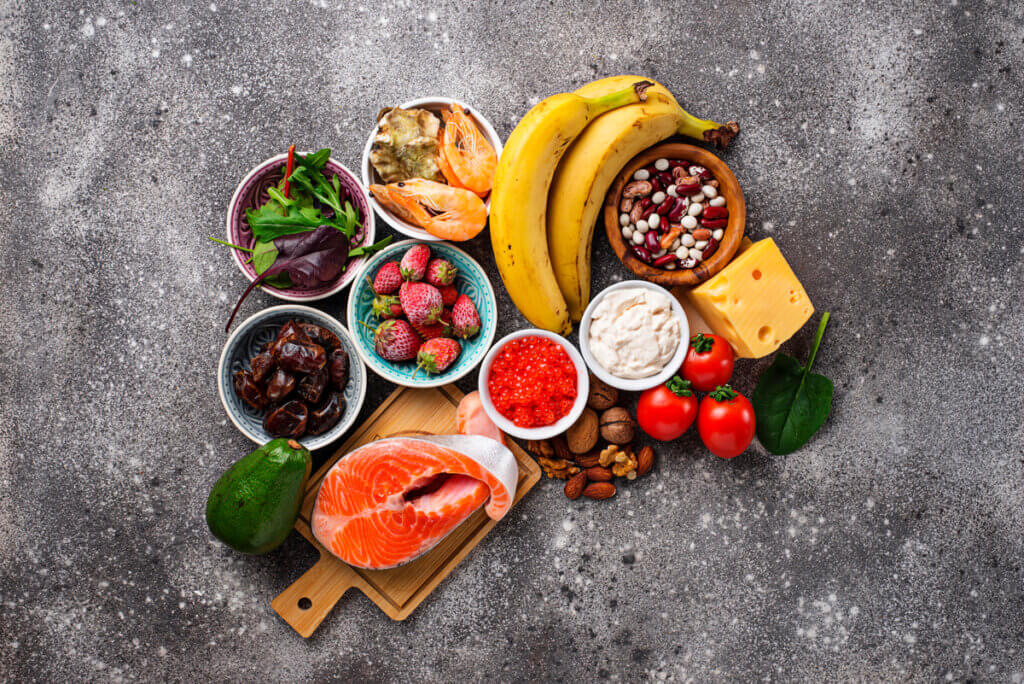What Is Tryptophan?


Escrito y verificado por la psicóloga Paula Villasante
Tryptophan is one of the 22 existing amino acids and an essential amino acid for our body. We get it from food, and, in fact, this amino acid is found in most proteins and is a precursor to serotonin.
Specifically, tryptophan is converted to 5-hydroxy-tryptophan (5-HTP) which, in turn, is converted into serotonin, an essential neurotransmitter for regulating sleep, appetite, pain, and mood. In addition, tryptophan is considered a natural sedative and is present in products such as meat, brown rice, fish, soybeans, and dairy products.
Due to its chemical structure, it’s known as LNAA (Large Neutral Amino Acid) and its circulating levels are influenced by the diet, especially those with a higher proportion of carbohydrates than proteins.
Specifically, L-tryptophan is used as a hypnotic agent in humans against sleep disorders. There’s an increase in the non-REM phase after its administration, which reflects the action in reducing latency, that is, the time that passes until we fall asleep.
Classification
Among the 20 amino acids that exist, tryptophan fits into the essential amino acids, along with arginine, leucine, isoleucine, methionine, phenylalanine, threonine, histidine and lysine. Due to its chemical structure it is within the LNAA, as we already said.
Ingestion, absorption and transport mechanism
After tryptophan enters the body through food, its circulating levels are influenced by diet, and specifically through macronutrients such as carbohydrates and proteins.
Amino acids are absorbed by four different active transport systems, one for each related group of amino acids: neutral, basic, acidic, and the one shared by hydroxyproline and proline. Amino acid transport occurs via the same sodium cotransporter mechanism that has been identified for glucose.
Almost all protein is absorbed upon reaching the end of the jejunum and only 1% of it can be found in the feces. Most of the endogenous proteins from intestinal secretions and squamous epithelial cells are also absorbed and digested from the small intestine.
Levels of the tryptophan/rest of LNNA ratio remain elevated in plasma when you follow a diet rich in carbohydrates and low in protein, which increases insulin levels in the blood. This favors the entry of LNNA cells that come from protein catabolism.
With this, what we achieve is having less LNNA in plasma. Once inside the brain cells, tryptophan is used in the synthesis of serotonin. This neurotransmitter has a role in sleep, through the raphe nuclei of the brain.

Keep reading: Threonine: An Essential Amino Acid for the Liver System
Tryptophan metabolism
Tryptophan follows 2 anabolic pathways that are as follows.
Anabolic pathway of biogenic amines
The first is that of biogenic amines, such as serotonin (5-HT), occurring in the argentaffin and enterochromaffin cells of the intestinal tract, where the greatest synthesis occurs. It’s then carried within the platelets by the blood.
The pineal gland, in addition to 5-HT, synthesizes the hormone melatonin, the limiting enzyme being N-acetyl transferase (NAT), whose activity depends on darkness; and Hydroxinol-O-methyl transferase (HIOMT).
The anabolic pathway from kynurenine
The second anabolic pathway of tryptophan metabolism develops from kynurenine. This is directed to the formation of nicotinic acid, that is, vitamin B3.
That’s why some professionals recommend the joint administration of vitamin B6 when tryptophan is high, as the biosynthesis of B3 is dependent on vitamin B6.
Regarding the metabolism time of tryptophan in humans, most of the metabolites (kynurenine, indole-acetic acid, and indoleacetic acid) reach their maximum levels 3 hours after administration. Levels remain elevated for 8 hours in plasma.
Application of tryptophan as a hypnotic
The use of tryptophan as a hypnotic agent dates back to the 1970s. This is because it’s a precursor to biogenic amines. In 1970, the researcher Wyatt found evidence that L-tryptophan administered at night produced an increase in sleep, particularly in the non-REM phase, both in healthy individuals and in patients with insomnia.
In the 1980s, Spinweber indicated that in men, the administration of 3 grams of L-tryptophan for 6 nights produced a decrease in sleep latency from the fourth night. For the chronic treatment of severe insomnia, its use with 2 grams daily for 4 weeks was recommended.
Later, in the 1990s, researchers administered it in vitro at 9 or 23 hours in a range of 1 to 5 grams. After that, they observed a significant increase in blood melatonin one hour after its administration, with concentrations of 3 and 5 grams, reflecting its significant action on sleep.
How effective is tryptophan?
We can say that L-tryptophan is the following:
- Possibly effective: For severe symptoms of premenstrual syndrome (premenstrual dysphoric disorder or PMDD). Taking 6 grams of L-tryptophan daily appears to decrease tension, mood swings, and irritability in women with this disorder. Also for smoking cessation (taking L-tryptophan seems to help people quit smoking when used with conventional treatment).
- Possibly ineffective: For bruxism and myofascial pain syndrome (this is a condition that causes persistent muscle pain and tryptophan doesn’t seem to help reduce the pain).
Effectiveness for athletic performance
Research shows that taking L-Tryptophan for 3 days before exercising can improve power during exercise. This enhancement helps increase the distance an athlete can cover in the same amount of time.
However, other studies show that taking L-tryptophan during exercise doesn’t improve endurance during cycling. So it seems that L-tryptophan may improve some measures of athletic ability, but not others. On the other hand, it may need to be taken for a few days prior to exercise in order to determine if there’s a benefit.
Other applications
In attention deficit hyperactivity disorder (ADHD) there’s some evidence that L-tryptophan levels are lower in these children. However, taking L-tryptophan supplements doesn’t seem to improve symptoms. On the other hand, regarding depression, it could improve the effectiveness of common medications used in the pathology.
For Helicobacter pylori infection, research shows that taking L-tryptophan in combination with the drug omeprazole improves ulcer healing rates compared to taking omeprazole alone.
Taking L-tryptophan by mouth might actually decrease the amount of time it takes to fall asleep and improve mood in healthy people with sleep problems. Also referring to rest, there’s some evidence that it reduces episodes of obstructive apnea in people who stop breathing periodically during sleep.

Discover more: What are Proteins of High Biological Value?
Tryptophan health risks and side effects
As a supplement, tryptophan can have many health benefits, but it can also cause a number of unpleasant side effects in people. According to the National Organization for Rare Disorders, tryptophan supplementation was linked to more than 1,500 reports of eosinophilia-myalgia syndrome (EMS) and 37 deaths in an epidemic in the late 1980s.
This amino acid can help treat the symptoms of some conditions, but it can increase serotonin levels too much, especially when combined with medications such as tricyclic antidepressants (TCAs), MAO inhibitors (MAOIs), pain relievers (tramadol and meperidine), triptan migraine medicines, and cough syrups containing dextromethorphan.
Neither is it recommended to take tryptophan if you’re taking selective serotonin reuptake inhibitors (SSRIs). And it seems that the increase in serotonin from tryptophan may defeat the purpose of SSRIs (such as citalopram, fluoxetine, and sertraline).
Although more research is needed in this regard, the most common adverse effects are gastrointestinal reactions, including:
- Heartburn and stomach pain
- Belching, vomiting and nausea
- Diarrhea
- Loss of appetite
The most serious side effects, which warrant immediate discontinuation of use, include the following:
- Drowsiness and lightheadedness
- Visual blurring
- Muscle weakness and fatigue
Ongoing research
Since we’re dealing with an essential amino acid, we know that we must acquire it through diet. However, studies for its use as a medicine are ongoing and, as far as insomnia is concerned, it’s promising. There’s still a long way to go to establish its safety, but the door to investigations is open.
Tryptophan is one of the 22 existing amino acids and an essential amino acid for our body. We get it from food, and, in fact, this amino acid is found in most proteins and is a precursor to serotonin.
Specifically, tryptophan is converted to 5-hydroxy-tryptophan (5-HTP) which, in turn, is converted into serotonin, an essential neurotransmitter for regulating sleep, appetite, pain, and mood. In addition, tryptophan is considered a natural sedative and is present in products such as meat, brown rice, fish, soybeans, and dairy products.
Due to its chemical structure, it’s known as LNAA (Large Neutral Amino Acid) and its circulating levels are influenced by the diet, especially those with a higher proportion of carbohydrates than proteins.
Specifically, L-tryptophan is used as a hypnotic agent in humans against sleep disorders. There’s an increase in the non-REM phase after its administration, which reflects the action in reducing latency, that is, the time that passes until we fall asleep.
Classification
Among the 20 amino acids that exist, tryptophan fits into the essential amino acids, along with arginine, leucine, isoleucine, methionine, phenylalanine, threonine, histidine and lysine. Due to its chemical structure it is within the LNAA, as we already said.
Ingestion, absorption and transport mechanism
After tryptophan enters the body through food, its circulating levels are influenced by diet, and specifically through macronutrients such as carbohydrates and proteins.
Amino acids are absorbed by four different active transport systems, one for each related group of amino acids: neutral, basic, acidic, and the one shared by hydroxyproline and proline. Amino acid transport occurs via the same sodium cotransporter mechanism that has been identified for glucose.
Almost all protein is absorbed upon reaching the end of the jejunum and only 1% of it can be found in the feces. Most of the endogenous proteins from intestinal secretions and squamous epithelial cells are also absorbed and digested from the small intestine.
Levels of the tryptophan/rest of LNNA ratio remain elevated in plasma when you follow a diet rich in carbohydrates and low in protein, which increases insulin levels in the blood. This favors the entry of LNNA cells that come from protein catabolism.
With this, what we achieve is having less LNNA in plasma. Once inside the brain cells, tryptophan is used in the synthesis of serotonin. This neurotransmitter has a role in sleep, through the raphe nuclei of the brain.

Keep reading: Threonine: An Essential Amino Acid for the Liver System
Tryptophan metabolism
Tryptophan follows 2 anabolic pathways that are as follows.
Anabolic pathway of biogenic amines
The first is that of biogenic amines, such as serotonin (5-HT), occurring in the argentaffin and enterochromaffin cells of the intestinal tract, where the greatest synthesis occurs. It’s then carried within the platelets by the blood.
The pineal gland, in addition to 5-HT, synthesizes the hormone melatonin, the limiting enzyme being N-acetyl transferase (NAT), whose activity depends on darkness; and Hydroxinol-O-methyl transferase (HIOMT).
The anabolic pathway from kynurenine
The second anabolic pathway of tryptophan metabolism develops from kynurenine. This is directed to the formation of nicotinic acid, that is, vitamin B3.
That’s why some professionals recommend the joint administration of vitamin B6 when tryptophan is high, as the biosynthesis of B3 is dependent on vitamin B6.
Regarding the metabolism time of tryptophan in humans, most of the metabolites (kynurenine, indole-acetic acid, and indoleacetic acid) reach their maximum levels 3 hours after administration. Levels remain elevated for 8 hours in plasma.
Application of tryptophan as a hypnotic
The use of tryptophan as a hypnotic agent dates back to the 1970s. This is because it’s a precursor to biogenic amines. In 1970, the researcher Wyatt found evidence that L-tryptophan administered at night produced an increase in sleep, particularly in the non-REM phase, both in healthy individuals and in patients with insomnia.
In the 1980s, Spinweber indicated that in men, the administration of 3 grams of L-tryptophan for 6 nights produced a decrease in sleep latency from the fourth night. For the chronic treatment of severe insomnia, its use with 2 grams daily for 4 weeks was recommended.
Later, in the 1990s, researchers administered it in vitro at 9 or 23 hours in a range of 1 to 5 grams. After that, they observed a significant increase in blood melatonin one hour after its administration, with concentrations of 3 and 5 grams, reflecting its significant action on sleep.
How effective is tryptophan?
We can say that L-tryptophan is the following:
- Possibly effective: For severe symptoms of premenstrual syndrome (premenstrual dysphoric disorder or PMDD). Taking 6 grams of L-tryptophan daily appears to decrease tension, mood swings, and irritability in women with this disorder. Also for smoking cessation (taking L-tryptophan seems to help people quit smoking when used with conventional treatment).
- Possibly ineffective: For bruxism and myofascial pain syndrome (this is a condition that causes persistent muscle pain and tryptophan doesn’t seem to help reduce the pain).
Effectiveness for athletic performance
Research shows that taking L-Tryptophan for 3 days before exercising can improve power during exercise. This enhancement helps increase the distance an athlete can cover in the same amount of time.
However, other studies show that taking L-tryptophan during exercise doesn’t improve endurance during cycling. So it seems that L-tryptophan may improve some measures of athletic ability, but not others. On the other hand, it may need to be taken for a few days prior to exercise in order to determine if there’s a benefit.
Other applications
In attention deficit hyperactivity disorder (ADHD) there’s some evidence that L-tryptophan levels are lower in these children. However, taking L-tryptophan supplements doesn’t seem to improve symptoms. On the other hand, regarding depression, it could improve the effectiveness of common medications used in the pathology.
For Helicobacter pylori infection, research shows that taking L-tryptophan in combination with the drug omeprazole improves ulcer healing rates compared to taking omeprazole alone.
Taking L-tryptophan by mouth might actually decrease the amount of time it takes to fall asleep and improve mood in healthy people with sleep problems. Also referring to rest, there’s some evidence that it reduces episodes of obstructive apnea in people who stop breathing periodically during sleep.

Discover more: What are Proteins of High Biological Value?
Tryptophan health risks and side effects
As a supplement, tryptophan can have many health benefits, but it can also cause a number of unpleasant side effects in people. According to the National Organization for Rare Disorders, tryptophan supplementation was linked to more than 1,500 reports of eosinophilia-myalgia syndrome (EMS) and 37 deaths in an epidemic in the late 1980s.
This amino acid can help treat the symptoms of some conditions, but it can increase serotonin levels too much, especially when combined with medications such as tricyclic antidepressants (TCAs), MAO inhibitors (MAOIs), pain relievers (tramadol and meperidine), triptan migraine medicines, and cough syrups containing dextromethorphan.
Neither is it recommended to take tryptophan if you’re taking selective serotonin reuptake inhibitors (SSRIs). And it seems that the increase in serotonin from tryptophan may defeat the purpose of SSRIs (such as citalopram, fluoxetine, and sertraline).
Although more research is needed in this regard, the most common adverse effects are gastrointestinal reactions, including:
- Heartburn and stomach pain
- Belching, vomiting and nausea
- Diarrhea
- Loss of appetite
The most serious side effects, which warrant immediate discontinuation of use, include the following:
- Drowsiness and lightheadedness
- Visual blurring
- Muscle weakness and fatigue
Ongoing research
Since we’re dealing with an essential amino acid, we know that we must acquire it through diet. However, studies for its use as a medicine are ongoing and, as far as insomnia is concerned, it’s promising. There’s still a long way to go to establish its safety, but the door to investigations is open.
- L-Tryptophan: MedlinePlus Supplements. (2020). Retrieved 18 October 2020, from https://medlineplus.gov/druginfo/natural/326.html
- Roso, Bala Ruíz, and María Luisa Bosqued Lorente. Triptófano. Editorial AMAT, 2012.
- Tryptophan. Retrieved 18 October 2020, from https://pubchem.ncbi.nlm.nih.gov/compound/L-tryptophan#section=Top
- The most commonly prescribed type of antidepressant. (2019). Retrieved 18 October 2020, from https://www.mayoclinic.org/diseases-conditions/depression/in-depth/ssris/art-20044825
-
Cubero, J., Rodríguez, A. B., Narciso, D., Valero, V., Sánchez, J., & Barriga, C. (2006). Anotaciones básicas sobre el aminoácido triptófano. Enfermería Global, 5(1).
- Cubero, J., et al. “Anotaciones básicas sobre el aminoácido triptófano.” Enfermería Global 5.1 (2006).
- Requejo, Ovidio Hernando, V. Hernando-Requejo, and Ana María Requejo Marcos. “Impacto de la alimentación en la lucha contra el insomnio.” Nutrición hospitalaria: Organo oficial de la Sociedad española de nutrición parenteral y enteral 37.2 (2020): 57-62.
- Gil, Manuel Arasa. Manual de nutrición deportiva (Color). Editorial Paidotribo, 2005.
Este texto se ofrece únicamente con propósitos informativos y no reemplaza la consulta con un profesional. Ante dudas, consulta a tu especialista.







